Puerto Consuelo (Part I)
The other day we told you about Puerto Natales, a town which doesn’t really deserve to be called a port. By the time one has travelled this far through the channels it has become evident that a puerto, in Chilean parlance, does not necessarily imply the presence of a quay or any other facilities appropriate to the berthing of a vessel, and it may not even mean a settlement. In fact, very few of the puertos in the Magellan Straits or the Beagle Channel are anything more than sheltered coves. But Natales… As I’ve explained previously, Natales has all the facilities that one might expect from the name, but it is not a safe anchorage. After you’ve made the long and devious detour to reach it, Puerto Natales is really rather a let down. However, there is one place in this vicinity which does provide a reasonably secure anchorage for yachtsmen – and that is Puerto Consuelo.
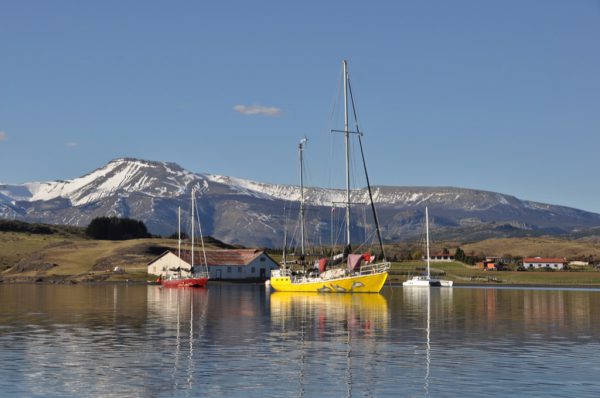
Consuelo was actually the first place in this region to be settled by Europeans. As the story goes, there was once a German sailor who captained a vessel engaged in trading between Punta Arenas and the Falkland Islands. Then as now, the Falklanders imported almost everything that was needed in the way of provisions and manufactured goods, but whereas the current principal export is frozen seafood, in past times it was wool. In the course of carrying the bales of wool to the mainland, Herr Eberhard evidently realised that there was a good living to be made from sheep farming, but he also seems to have reckoned that those windswept Atlantic islands were not the place he wanted to settle down. Thus, eventually – being ready to give up the life on the ocean wave, and having saved sufficient money to buy a flock of sheep – he set off to find some other suitable venue. According to the legend, he embarked on this voyage of exploration all alone, in a rowing boat.
Having spoken to Herman Eberhard’s great-grandson, it would seem that in reality the captain was accompanied by two other Germans; and reading between the lines, I suspect that they probably travelled in a whaleboat. This was the vessel traditionally used by the British navy for surveying work, and it was the one used by Robert FitzRoy and Pringle Stokes and William Skyring when they explored Chile’s narrow channels and fiords.
The end result of the famous survey conducted by these men on behalf of the Admiralty was a set of Sailing Directions for Argentina, Chile, and Peru. As the captain of a trading vessel working in these waters, Eberhard will certainly have had a copy of this work. I imagine that he also had a copy of the full account of the British surveying voyage, and from this he will have known of the whaleboat’s practicality for the task that he had in mind.
A whaleboat was usually schooner-rigged, with gunter-gaff fore-and-aft sails, but when the wind was contrary and strong, or when the weather was completely calm, then she would be rowed by six oarsmen – and thus, I suspect that Eberhard and his friends also hired three or four crew for their adventure.
Eberhard and his companions are said to have visited several locations before the captain selected Consuelo for his ranch; and if I am right in thinking that he was following in the footsteps of the British surveyors I suspect that the first place which he explored may have been the Otway Water. This vast lake, which is easily reached from the Magellan Straits, was discovered by FitzRoy some seventy years before Eberhard’s expedition, and the young British officer had specifically described it as being much more suited to settlement than the wet and windy Straits.
But Eberhard, if he visited it at all, did not agree; he continued west. Perhaps he wanted somewhere even more remote, or perhaps he simply couldn’t find water. I picture him thumbing though the Sailing Directions and reading William Skyring’s account of his explorations in the channels of Chile’s Pacific coast. Skyring travelled through the spine of the Andes and discovered another inland lake – a lake which does not connect with the Straits and which can only be reached via a devious passage through the channels. This lake, he reported, was bordered by low land covered in trees.
Eberhard surely knew that most of the land in Tierra del Fuego and Chilean Patagonia was unsuited to sheep farming. Most of it was either mountainous or boggy – or both; but this terrain sounded different. Perhaps by following in Skyring’s footsteps and doubling back through the Andes, he might find what he needed.
According to the legend, Herman Eberhard travelled up the Smyth Channel and when he reached Bahia Isthmus he dragged his boat across the narrow neck of land which divides Smyth from Union Canal. Perhaps he stopped for the night on Isla Jaime or in Skyring’s Whaleboat Sound. Then he passed through the narrows – and through the Andes – and came upon the lake, or gulf. (Skyring named it Worsley Sound, but that name has been shifted to a fiord occupying one corner and the lake itself is now known as the Golfo Almirante Montt.)
Having crossed the lake, Eberhard continued up into the fiord on its opposite shore. As the story goes, this was to be his last attempt to find a suitable place for a ranch – after this he was giving up – and so he named it Ultima Esperanza.
Well, no… actually, he didn’t. Eberhard didn’t name the estero. According to the local Natales council, it was named by one Juan Ladrillero, a Spanish captain who came here in the 16th century while trying to find the western entrance to Magellan’s strait – but that’s not true either! In reality the place was named by William Skyring, for whom it was the ‘Last Hope’ of finding a way through from the Pacific channels, via the Otway Water, into the Straits.
I have not been able to learn anything about Juan Ladrillero’s voyages, and nor were those 19th century British surveyors aware of his existence. They did have the accounts of other Spanish explorers, including Sarmineto – but Sarmiento failed to find the narrow passage into the gulf. Skyring certainly believed that he and his men were the first Europeans to discover the place; and certainly the names which are used for the various channels, fiords, and bays in this vicinity were all invented by him and do not derive from an earlier source. This is apparent from the Account of the voyages.
But I digress…
Having sailed the length of the lake, Herr Eberhard and his men spent the night camped beside a small stream just within the mouth of the Last Hope estero; and, it being Christmas, they named the stream in honour of the Birth of Jesus. (Yes, this was the place where Natales would soon be founded.)
On the following day the expedition pressed on, following the northern shore of the Ultima Esperanza estero, and after a couple of hours of pulling they reached a small inlet. This inlet was not mentioned in the Admiralty Sailing Directions but it evidently appealed to Eberhard and he chose to take this turning. I picture him and his companions battling their way into the teeth of the prevailing wind – and thus the legend of a voyage made under oars.
The men passed an islet, where the wind was so fierce that it seemed to have torn the soil from the hillsides; and on the far side of this pass – which they named Angostura Diablo, or the Devil’s Narrows – they arrived in a small bay which was backed by rolling countryside.
The year was 1893; and the erstwhile captain had found the thing which he sought. Henceforth, he would be a sheep farmer and the owner of the first estancia – and the first house – in Chilean Patagonia.
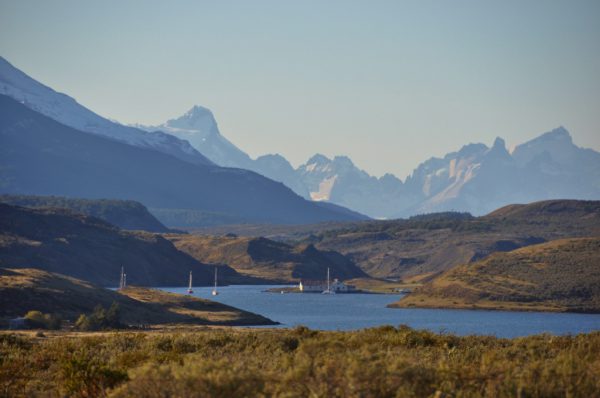
Besides christening the place which would someday be the site of Puerto Natales, Herman Eberhard also named the mountain behind the town and he named a nearby lake. The mountain is named after his elder daughter, Dorotea, and the lake for the younger child, Sofia. As for Consuelo – I have not been able to discover why he called his new home by this name since even his great-grandchildren do not seem to know. Consuelo is a girl’s name and it may be that it was Fraulein Eberhard’s name; however, the word also means consolation, and my own theory is that the soon-to-be sheep-farmer reckoned that it was in keeping with the names given by those earlier explorers. For them, this far-flung corner of a remote lake meant the end of their hopes of a passage through to the Straits of Magellan, but if the land could be settled then that would be some consolation.
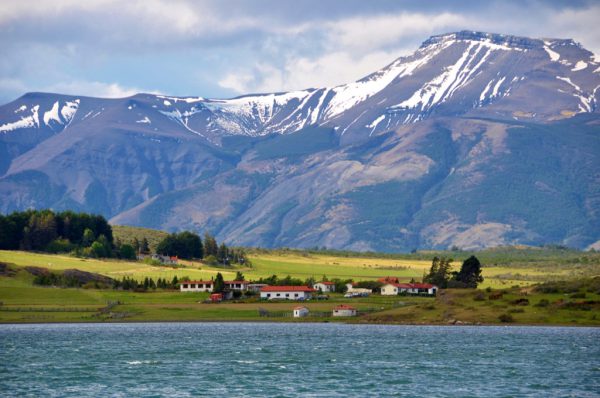
Had it been me, I would not have chosen this place to settle. I would have plumped for the northern shore of the gulf, perhaps in the place where Estancia Riquelme was subsequently founded. In fact, upon refection it seems that I may be wrong in imagining that Eberhard disdained to drop his hook in the Falklands because of the climate; at the head of the creek which now carries his name he had found a place which was scarcely warmer and equally windy. The difference was that the land here was up for grabs. The Chilean government was actively seeking to encourage settlement, and so the German pioneer had no trouble in acquiring the title to 12,000 hectares (30,000 acres).
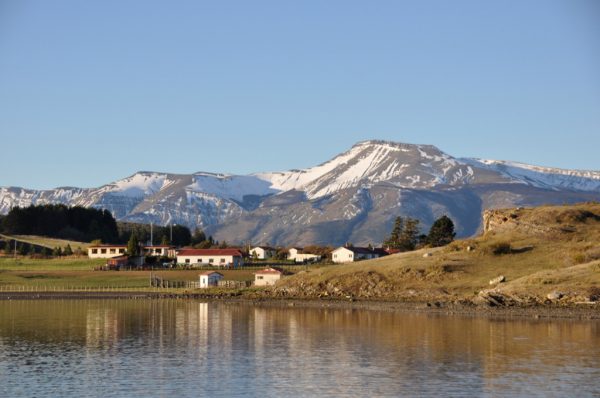
For what it’s worth, the Chilean government is still eager to encourage settlement, albeit any would-be colonists must now go even further south, to Puerto Williams or to the new town which has been proposed for the middle of Tierra del Fuego. If you fancy being a frontiersman, it is said that plots are available here for free.
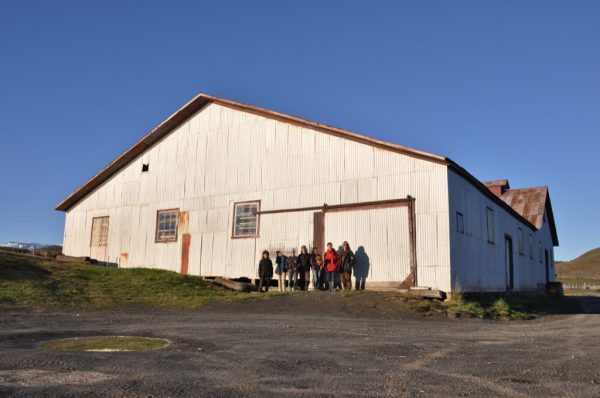
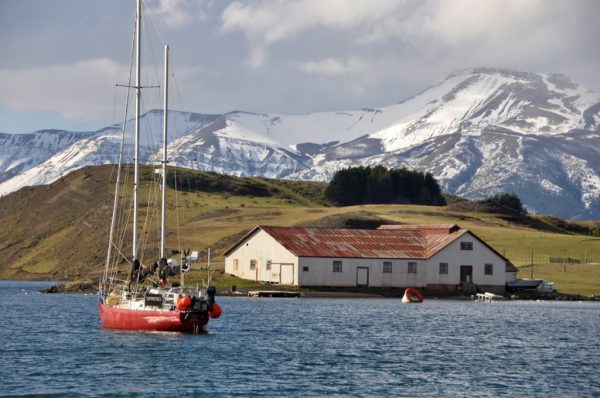
The house which Herman Eberhard built was not actually on this site. It stood a further mile up the narrow ravine, on the western shore. The old man was dead and gone by the time his sons decided to shift their dwelling to this more convenient place, with easier access to the new settlement of Puerto Natales and the slaughter-house.
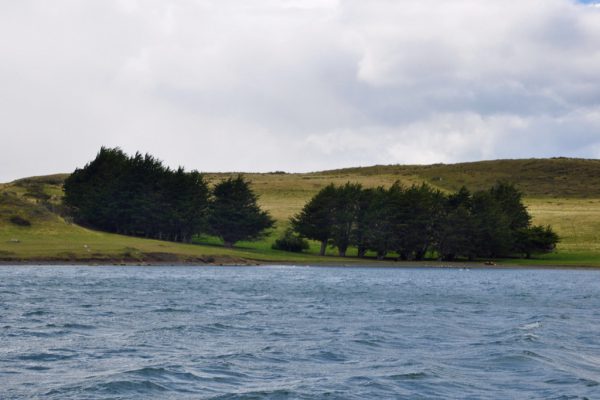
With the discovery of ways to make artificial wool and the subsequent revolution in the clothing industry, in the mid-20th century the bottom fell out of the wool market – and so Eberhard’s sons switched to rearing beef cattle. A further setback occurred when Salvador Allende’s socialist government decided on a redistribution of the land. Big estancias such as this one were divided up and the farmworkers given their share. One cannot help thinking that this adjustment of the situation seems perfectly fair and right. As the man said, “Property is theft”. However, the man hadn’t reckoned with human nature. It transpired that the workers didn’t actually aspire to manage their own small-holdings; they preferred to be wage-earners – and they preferred the idea of a lump sum of cash – and so most subsequently sold their plots. It is said that many of the estancias actually grew bigger as a result of the land redistribution policy. However, the Eberhard family did not buy back any land, and Estancia Eberhard is now only 5,000 hectares – which is the equivalent to just 12,500 football pitches…
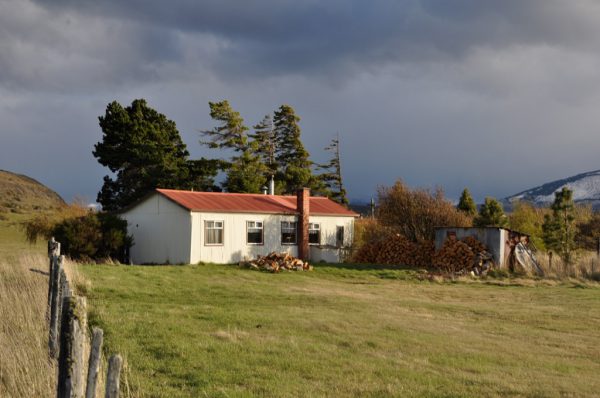
When Skyring and his men explored this area it was so thickly wooded that they found it impossible to penetrate inland, but Eberhard soon got rid of the trees. Indeed, it is said that the Chilean government paid the settlers to do so. This eagerness to open up the area has resulted in the sudden destruction of miles and miles of scrub forest, much of which was removed by the simple and most cost-effective expedient of setting fire to it; and the result of that has been climate change.
No doubt the climate would have changed anyway – because the climate is changing all over the world – but removing the tree cover is a classic way to reduce rainfall. The lack of rain has resulted in impoverishment of the vegetation, so that the farmers now need ten hectares (or an area the size of ten football fields) to support each beef cow. Even then, after the animals have reached their adult size they have to be sold on and taken elsewhere for fattening.
Another problem which Great-Grandfather Eberhard didn’t have to deal with was cattle rustlers – or if he did, it was not on a commercial scale. To prevent the theft of the cows, each of which is worth upwards of £250, Estancia Eberhard is patrolled by gauchos. Eric Eberhard told me that his Uncle Rudi, who is now in charge of the place, has fifty horses, half of which are employed in riding around the estate and herding the family’s 500 Aberdeen Angus.
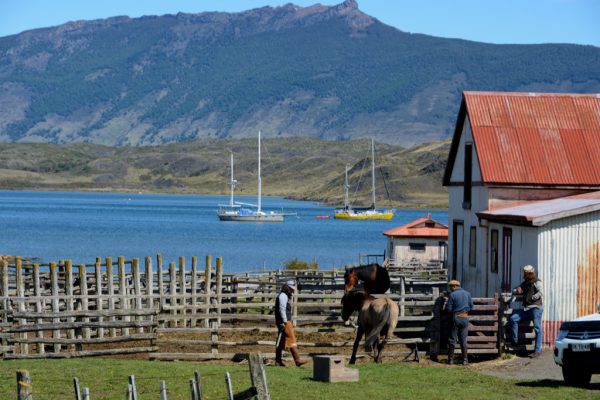
The other horses are used for ‘hacking’ – because that is the family’s latest line of business. The sign on the gate says, ‘Agrotourism’. Besides renting out the horses, the Eberhards have also opened a restaurant in one of their cottages. The punters arrive every day aboard a floating coach called Tonina. They have already visited the local glacier, at the head of the Ultima Esperanza inlet, and now they will dine at the historic ranch, eating farmed salmon and roast lamb.
(We haven’t sampled the fare, partly because we don’t eat salmon or lamb but also because such activities fall well outside our budget.)
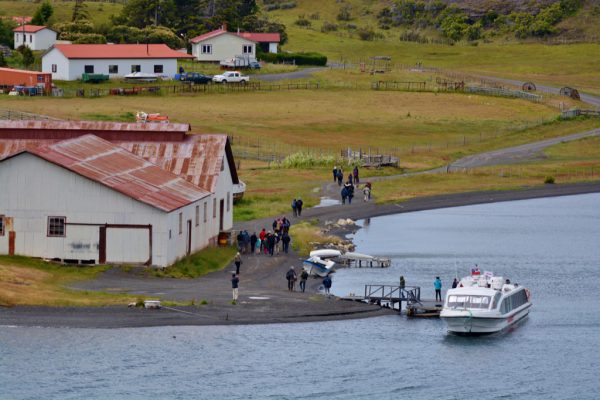
Next week we’ll tell you all about the prehistoric beast which Herman Eberhard found in his back garden and which Bruce Chatwin’s grandfather stole.
